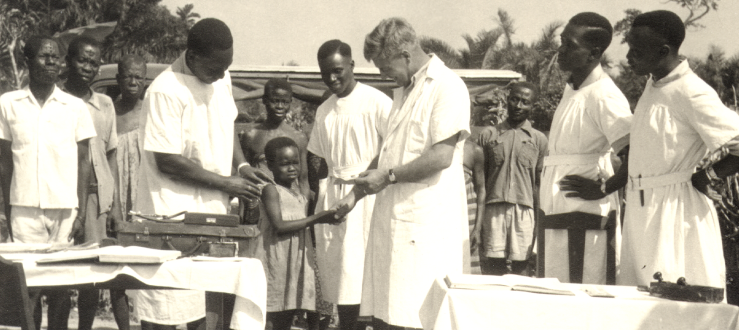The history of leprosy
The history of leprosy

Leprosy is both an ancient and a modern disease
Many people think of leprosy as an ancient disease. That is both wrong and right.
The earliest evidence we have of leprosy is a skeleton in India that dates back 4,000 years. There are references to leprosy in the Bible and in the scriptures of other major faiths. This makes leprosy a disease with ancient roots.
However, leprosy is also a modern disease, with roughly 200,000 people diagnosed with the disease every year.
Leprosy in Medieval Europe and the spread across the world
Many depictions of leprosy in modern popular culture derive from our understanding of leprosy in Medieval Europe. It is believed the disease first originated on the Indian subcontinent but by 1200 CE, there were an estimated 19,000 leprosy hospitals in Europe. It is believed the disease was most likely spread to Europe through trade routes and by travelling armies.
One of the most famous persons affected by leprosy from this period was Baldwin IV, King of Jerusalem in the 12th century. He is known as ‘the Leper King’, but the term ‘leper’ is now considered to be highly derogatory and The Leprosy Mission encourages everyone to use the term ‘person affected by leprosy’.
The incidence of leprosy began to decline quite suddenly around the 1400s and had died out of most European countries by the 1600s.
The reason for this decline is not well understood. Some people believe it is due to the increased quality of living conditions, including nutrition and clean water and sanitation. An improvement in these areas leads to improved immune systems and a greater chance of resisting the germ that causes leprosy.
Another theory relates to the spread of tuberculosis. The TB and leprosy germs are very similar and some believe that an immunity to leprosy developed in Europe as TB spread across the continent.
It was European colonists and victims of the African slave trade that are believed to have spread the disease to the Americas.
Understanding of leprosy has improved over the last 150 years
When leprosy is not treated, it can cause serious impairments. In the days before a treatment for leprosy was identified, it could lead to severe disfigurements.
Much of the stigma and fear that surrounds leprosy is a residue of the days when the disease had no treatment and the transmission was poorly understood. People were isolated in leprosy sanatoriums and the ruins of these sanatoriums can still be found across the world today.
Since the late 1800s, the understanding of leprosy has improved dramatically and there is no longer reason to fear the disease.
In 1873, a Norwegian physician called Gerhard Armauer Hansen discovered Mycobacterium leprae, the bacteria that causes leprosy. This discovery was a major breakthrough, which enabled scientists to understand how the disease is transmitted and identify medications that can cure the disease. Today leprosy is also known as Hansen’s Disease, in honour of Gerhard Armauer Hansen.
In the 1940s, a medicine called dapsone was used to treat leprosy, but by the 1960s, the M.leprae bacteria had started to develop resistance to dapsone monotherapy. So scientists developed a new multi-drug regimen of dapsone added to other drugs: rifampicin and clofazimine. Since 1981, the WHO has provided Multi Drug Therapy (MDT), across the world free of cost. They estimate that more than 16 million people have been treated with MDT over the past 40 years.
As well as the breakthrough by Gerhard Armauer Hansen, the 1870s was the beginning of the world’s first leprosy organisation, The Leprosy Mission. Our founder, Wellesley Bailey, started the Mission after a visit to India, where he met people who were suffering horrible consequences because of leprosy. You can learn more about our history here.
Leprosy today
The cure for leprosy is now readily available and we understand that leprosy is not highly contagious. There is no reason to isolate any person because of leprosy and if the disease is treated quickly, leprosy does not cause any long-term complications.
In recent years, scientists have identified that rifampicin can prevent leprosy, as well as cure it. This has led to the development of programmes to distribute rifampicin as a post-exposure prophylactic and further research to identify the best combination of antibiotics to prevent leprosy.
Further work is being done on diagnostic tools that will enable us to diagnose leprosy within minutes and on a vaccine for leprosy.
Around 200,000 people are diagnosed with leprosy each year. Most cases of leprosy today are found in Asia, Africa, and South America, with two thirds of the cases being diagnosed in India.
Although treatment is effective and readily available, many people are diagnosed too late to prevent leprosy-related disabilities. This makes leprosy one of the world’s leading causes of preventable disability.
The Leprosy Mission is working to raise awareness of leprosy across Asia and Africa so that people can recognise the early signs and symptoms of the disease and to break down some of the myths that allow leprosy stigma to continue.
Our goal is to end the transmission of this 4,000 year old disease by 2035. We have all the tools and knowledge we need to make that happen, we just need the political commitment and the resources. If you want to be a part of the generation that ends leprosy for good, you can donate today.